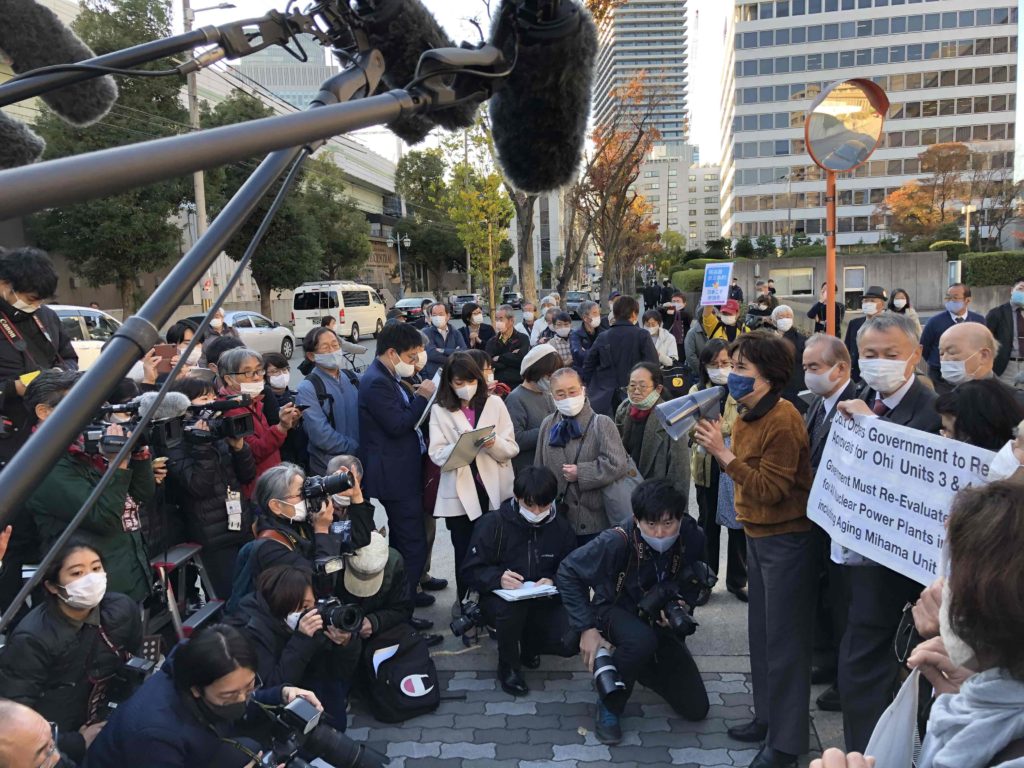21 June 2018
Dear Director General Yukiya Amano,
We are writing to you in advance of a submission by the Government of Japan on its plutonium stockpiling program. It is our understanding that the IAEA will receive by the end of this month an explanation from the Abe administration on how Japan intends to respond to growing international criticism of its plutonium stocks, which in 2016 stood at 46,900 kilograms. As with its earlier commitment to maintain its plutonium stockpile to the minimum level made by the Abe administration at the Hague Summit in 2014, we predict the same meaningless rhetorical commitments in June 2018.
The information to be submitted by the Japanese government will likely cite current policy, applied in 2003 and restated in its July 2017 Basic Policy for Nuclear Energy, “not to possess plutonium without specific purpose.” This notification to you is a warning that any commitment made by Japan on plutonium will once again, almost certainly, be based on wholly unrealistic ambitions for managing its stocks of plutonium to attain equilibrium in its supply and demand. The current crisis in the nations nuclear industry, which is certain to continue, holds no prospect for large scale plutonium stock reduction. As you are aware, this is not a new plutonium problem only emerging in recent years.
Nearly thirty years ago we exposed the risks and threats posed by Japan’s plutonium program. In 1999, we wrote to your predecessor, Mohamed ElBaradei, citing the predictable failure of Japan’s plans to utilize plutonium in the form of Mixed Oxide Fuel (MOX) fuel both in its stalled Fast Breeder Program and in Light Water Reactors. At that time, Japan’s plutonium stocks were 5,318kg held domestically, with a further 27,309kg held at reprocessing plants in the UK and France. The latter had grown dramatically from 10,844 in 1992 to this higher amount in less than 7 years. At that time there was no prospect of even this large amount of direct use weapons material being used in Japan’s LWR MOX program. At that time we warned the Director General that there was no justification for a planned plutonium MOX shipment to the Fukushima Daiichi unit 3 and Takahama unit 4 reactors, citing that the justification offered by the Government of Japan was, “false, given the lack of real demand for plutonium reactor fuel, its poor economics, as well all the environmental, human health and the direct proliferation risks it poses.”
The inaction of the IAEA to address these issues in the 1990’s to the present has in part contributed to the current situation which has escalated as we predicted. The current stockpile of Japan’s plutonium amounts to approximately 9,800kg held domestically, in addition to 37,100kg in Europe (20,800kg at the NDA Sellafield plant in the UK and 16,200kg at the Orano la Hague and Melox plants in France). This stock will increase by a further 1000kg in 2018 with transfer to Japanese utility holdings at the Sellafield plant. The growth of any nations stockpile of fissile material is of legitimate concern, but the case of Japan is unique, having grown from 10.8 tons to 47.9 tons in 25 years. As we urged in 1999, a first important international step in reducing the safety and proliferation risks of plutonium worldwide, and which remains even more urgent today, is the immediate cessation of all weapons-usable plutonium separation and use, whether for stated military or civil use. Ultimately, only a comprehensive fissile material treaty that ends all commercial trade in fissile material will be sufficient to counter the threats posed by the Japanese and other nations plutonium programs. We realize that as a former senior diplomat for the Government of Japan who actively promoted Japan’s right to pursue plutonium production and MOX use, a Comprehensive Fissile Material Treaty runs counter to your historical position , but in the interests of effective non proliferation there is no alternative.
The Fukushima Daiichi accident, as you know, involved a partially MOX fueled reactor in unit 3. The efforts of civil society in Japan, opposed to the inherent reduced safety margins of MOX use, led to Tokyo Electric Power Company (TEPCO) being prevented from MOX loading in 1999 at Fukushima Daiichi as well as at the Kashiwazaki Kariwa unit 3 reactor. TEPCO finally loaded approximately 225 kg of plutonium in 28 Belgonucleaire / Cogema MOX fuel assemblies in unit 3 in August/September 2010. You are well aware of what happened less than six months later in March 2011.
Less acknowledged is that if TEPCO had proceeded with its MOX plans as scheduled in the 1990’s, there would potentially have been many hundreds of tons of spent MOX fuel in the Fukushima Daiichi reactor pools, as well as in the core fuel of units 3 and potentially at least one other reactor at the site. As the International MOX Assessment (IMA) in 1997 detailed, the consequences of a severe accident at a MOX fueled reactor are a/ more likely, and b/ involve greater consequences. These include a higher release fraction of plutonium into the environment with resultant increased latent cancer risks. Perhaps even more consequential would have been the heightened risk of loss of cooling function at the Fukushima Daiichi spent fuel pool(s) due to the higher heat generation of spent MOX fuel. As you also know, the Atomic Energy Council (AEC) provided analysis to then Prime Minister Naoto Kan on 25th March 2011. Th AEC analysis warned that loss of cooling function and control at the spent fuel pools at Fukushima Daiichi, would have required potentially the evacuation of an area 150-250km from the nuclear plant. Rather than the necessary evacuation of 164,000 Japanese citizens, the nation could have been confronted with having to evacuate 50 million people, including those resident in Tokyo. As Prime Minister Kan was to say,
The future existence of Japan as a whole was at stake,” he said. “Something on that scale, an evacuation of 50 million, it would have been like a losing a huge war…We were only able to avert a 250-kilometre (160-mile) evacuation zone [around the plant] by a wafer-thin margin, thanks to the efforts of people who risked their lives. Next time, we might not be so lucky.
Luck indeed played a role in preventing water levels from being reduced in spent fuel pool unit 4, but it was also the efforts of civil society to prevent TEPCO’s full scale MOX fuel program that most likely prevented the Fukushima nuclear disaster from being cataclysmic. This recent history is important to understand in the context of the expected communication from the Japanese government to the IAEA and the U.S. State Department later this month. Japan’s plutonium MOX plans were always a dangerous fantasy – they were decades ago – and they are even more so today.
Our analysis over recent years, and to the present, indicates that Japan will fail to meet its nuclear restart target of 30GW by 2030 by a wide margin. Many more nuclear reactors are likely to be decommissioned in the coming years, joining the 17 that have been declared such since 2011. Legal challenges are underway at most nuclear plants across Japan, with four reactors currently loaded with plutonium MOX fuel (though one of these, Ikata-3, is shutdown after a citizen lawsuit secured an injunction from the Hiroshima High Court in December 2017 that will run until September 2018, but with possibility of further extension from the lower court.)
Japanese utilities have recently recommitted to operating with 16-18 reactors with plutonium MOX fuel. Given that it is unlikely that even this number of reactors in total will operate in the future, this vague and meaningless statement is less to do with the reality of the crisis Japanese utilities find themselves in, but rather a token offering to the Government to provide weak justification for business as usual in nuclear fuel cycle policy. The Federation of Electric Power Companies (FEPC) has history on this issue, having made the same commitment more than 20 years ago in 1997. Neither then nor today is their pledge credible.
In addition to the four reactors that have resumed operation with partial MOX fuel cores, it is uncertain how many of the remaining six reactors that have received MOX approval will actually restart during the next 10 years. They are all confronted with multiple challenges, including seismic faults, as well as legal and political opposition. Of the remaining six units, five are at high risk of never restarting, specifically Kashiwazaki Kariwa-3, Shika-1, Hamaoka-4, Tomari-3, Onagawa-3. Even if they were to restart and based on past performance there is little prospect of all these reactors attaining a one-third MOX core within the coming decade. As a consequence, if we suspend reality and take industry commitments seriously, Japan’s annual plutonium demand could in theory reach at most between 1-2 tons of plutonium per year. This would require at least one plutonium MOX fuel shipment each year from Europe – something never achieved in the past decades and unlikely to do so in the future. Nevertheless, even if that rate of plutonium demand could be attained it would be sometime between 2034 and 2056 before Japan’s plutonium stock in Europe was reduced to zero. Yet even that medium term timescale is not possible. Three of the reactors currently operating with MOX fuel, Takahama-3 and 4 and Genkai-3, will surpass 40 years operation in 2024 and it is unclear whether they will operate beyond that. A further six of MOX licensed reactors will exceed forty years by 2034. The future operation of conventional uranium fueled nuclear reactors in Japan remains highly uncertain, but it is even more so for those seeking to load plutonium MOX fuel, which will be strongly resisted by local populations, politicians and ourselves. One thing that is certain, any pledge by Japan to significantly reduce its plutonium stocks through MOX use will fail, as it has these past decades.
At the same time, Japan remains committed to the commercial operation of the 2.9 trillion yen ($26.37 billion) Rokkasho-mura reprocessing plant in Aomori prefecture, with the potential to separate an additional 8000kg of plutonium each year. We long considered it near impossible that the plant would operate at full capacity – primarily for technical and design flaw reasons. The only reactor project that is relevant to Rokkasho-mura’s operation is the under construction Ohma ABWR in Aomori prefecture. Plans to operate this reactor with a 100 percent MOX core, amounting to as much as 5 tons of plutonium, remain the last hope for Japan’s nuclear fuel cycle. Yet, the reactor remains unfinished and subject to two lawsuits seeking its cancellation. Planned and delayed in the 1980’s, originally planned for operation by 2012, then 2014 its latest, but still unrealistic, schedule is for construction and possible operation to be finished in “2023 or 2024”. Even its owner, J-Power, which has only operated one experimental reactor in its history, acknowledges that, “It is still undecided about the operation start time.” Sitting in a high seismic zone and at risk from volcanic ash eruptions, the prospects of a successful operation of this unprecedented plutonium experiment as planned are close to zero. While J-Power and the Japanese government remain uncertain as to when the Ohma plant will commence operation, the citizens and city council of Hakodate, are committed to preventing its operation through lawsuits against the company and central government.
Any commitment made to the IAEA and the U.S. State Department by the Japanese government to only operate the Rokkasho-mura reprocessing plant to meet legitimate plutonium demand, is a clear contradiction. The only logical solution is for plans for commercial operation of the plutonium plant to be suspended indefinitely, leading to eventual decommissioning. Taking all these factors into account, there are no credible prospects for Japan to significantly reduce its plutonium stockpiles over the coming years through MOX fuel utilization.
Inexcusably, over many decades the IAEA has provided technical support and political justification for Japan’s wholly uneconomic and failed plutonium programs. To this day your Agency continues to actively promote the development of plutonium based plutonium fuel cycles, so called Generation IV technology, against all the historical evidence of its failure and in disregard for the safety, environmental and proliferation implications. One honorable exception was IAEA Deputy Director, William J. Dircks, who in 1992 at a meeting of the Japan Atomic Industrial Forum (JAIF) stressed the, “urgent need to review once again our policies regarding plutonium and its use,” warning that the, “adverse economics of MOX fuel utilization” would result in MOX providing “little help…in dealing with surplus plutonium.” Having failed to heed this warning and those of many others, including those submitting this letter, successive Japanese governments and the IAEA have instead overseen a dramatic growth in so-called civilian but nuclear weapons usable plutonium stocks, including those of Japan, over the past quarter of century. We have little faith that the IAEA will act effectively this time. We would, however, be pleasantly surprised if we were to be proved wrong and a decision was made by the IAEA to take up the call to action by the IAEA’s former Deputy Director and civil society which is even more relevant and urgent today than it was nearly three decades ago.
Continued inaction by the IAEA and its continued active support for Japan’s plutonium program is a willful degradation of your institutions stated duty and commitment to effective non proliferation. However, given the IAEA’s track record, we will not be waiting for action on your part. Instead, we are confident and determined that civil society and the people of Japan, as in the years prior to March 2011, will act to protect our environment, health and economy from the threat of future severe accidents from this bankrupt plutonium program, leading ultimately to a policy change and the end of Japan’s nuclear fuel cycle program.
Hideyuki Ban
Co-Director
Citizens’ Nuclear Information Center
Akebonobashi Co-op 2F-B, 8-5 Sumiyoshi-cho,
Shinjuku-ku, Tokyo, 162-0065, Japan
Aileen Mioko Smith
Director
Green Action
Suite 103, 22-75 Tanaka Sekiden-cho
Sakyo-ku, Kyoto 606-8203
Japan
Shaun Burnie
Senior Nuclear Specialist
Greenpeace Germany,
Attention to Greenpeace Japan,
8 Chome−13−11 NF bldg 2F
Nishishinjuku,
Shinjuku, Tokyo 160-0023,
Japan
PDF: Open Letter to the Director General Yukiya Amano, International Atomic Energy Agency (IAEA) 21 June 2018





